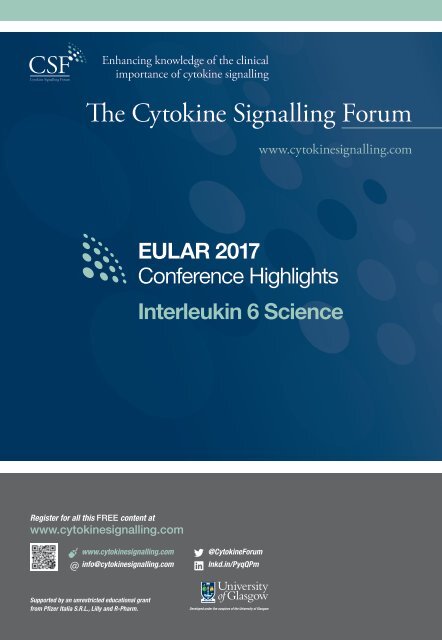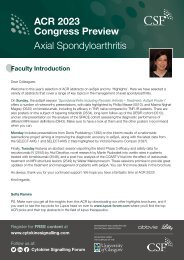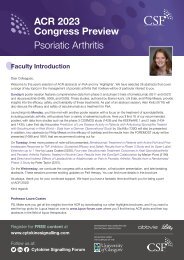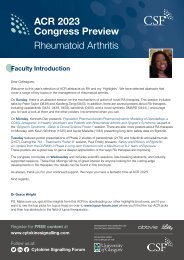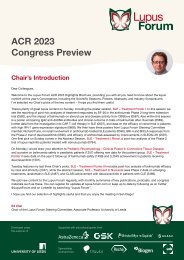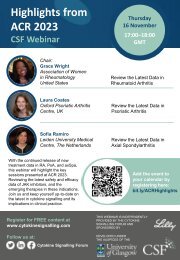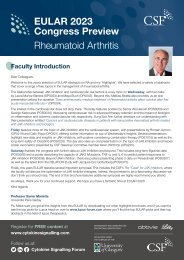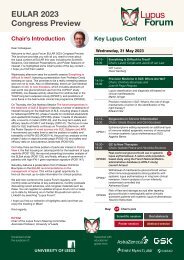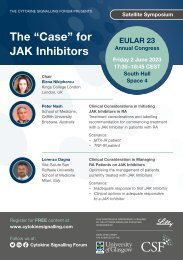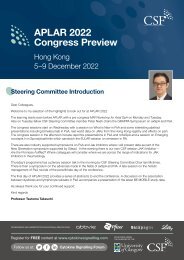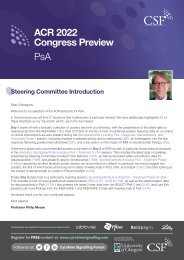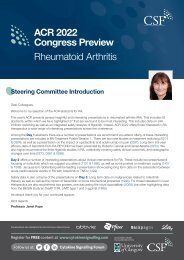EULAR 2017 IL6 Review
You also want an ePaper? Increase the reach of your titles
YUMPU automatically turns print PDFs into web optimized ePapers that Google loves.
Enhancing knowledge of the clinical<br />
importance of cytokine signalling<br />
The Cytokine Signalling Forum<br />
www.cytokinesignalling.com<br />
<strong>EULAR</strong> <strong>2017</strong><br />
Conference Highlights<br />
Interleukin 6 Science<br />
Register for all this FREE content at<br />
www.cytokinesignalling.com<br />
www.cytokinesignalling.com<br />
info@cytokinesignalling.com<br />
@CytokineForum<br />
lnkd.in/PyqQPm<br />
Supported by an unrestricted educational grant<br />
from Pfizer Italia S.R.L., Lilly and R-Pharm.<br />
Developed under the auspices of the University of Glasgow
Chairman’s Welcome<br />
<strong>EULAR</strong> <strong>2017</strong> Conference Highlights<br />
Interleukin 6 Science<br />
Dear CSF Member,<br />
Thank you for your continued support of the Cytokine Signalling Forum. We are now in our fourth year, and continue to strive to bring<br />
you the most up-to-date and interesting data in cytokine signalling. To that end, I am delighted to share with you our pick of the <strong>EULAR</strong><br />
highlights for <strong>2017</strong>. We have identified the most interesting and impactful abstracts being presented at this year’s meeting on both cytokine<br />
signalling and IL-6. I have also selected my ‘Chairman’s picks’: those abstracts that I feel are the most significant at this year’s congress.<br />
Cytokine Signalling<br />
Again, this year there is an interesting range of both basic and clinical science. There are several baricitinib posters covering durability<br />
and maintenance of efficacy [FRI0096], switching to monotherapy [SAT0058], and dose reduction [SAT0072]. The possibility of an<br />
anti-inflammatory biomarker profile in patients treated with filgotinib monotherapy is examined [THU0182], and the results of the DARWIN-3<br />
open label extension study up to 144 weeks are presented in Thursday’s poster session and tour [THU0173].<br />
Tofacitinib posters in RA concentrate on long-term safety and efficacy over eight years [THU0197] as well as an examination of<br />
cardiovascular risk factors [SAT0686], and safety and efficacy in patients with an inadequate response to conventional synthetic or biologic<br />
DMARDs [THU0185]. Real-world tofacitinib drug-retention data are also shared as a poster from the Swiss SCQM registry [THU0174];<br />
and real-world tofacitinib monotherapy data from the US CORRONA registry as an oral presentation [OP0022]. Three further oral<br />
presentations on Thursday and Friday will share exciting new data from the Phase 3 tofacitinib studies in psoriatic arthritis [OP0202;<br />
OP0216] as well as long-term effectiveness of live zoster vaccine in patients with RA, subsequently treated with tofacitinib [OP0230].<br />
IL-6<br />
Several abstracts showcase key data from the clinical programmes of sarilumab, sirukumab and tocilizumab.<br />
There are three key presentations on sarilumab, including patient-reported (PROs) from two Phase 3 studies in RA [FRI0240], and efficacy<br />
and patient-reported benefits of sarilumab monotherapy versus adalimumab monotherapy in the MONARCH study [SAT0202; OP0102].<br />
Sirukimab posters focus on Phase 3 data in RA, with efficacy and safety from the SIRROUND-T study [FRI0214], analyses of health-related<br />
quality of life and work productivity from SIRROUND-D and -T, respectively [FRI0246; FRI0251], and an integrated safety analysis of the<br />
SIRROUND programme [SAT0194].<br />
Tocilizumab oral presentations examine tapering and dose reduction strategies [OP0104] as well as the long-term safety profile seen in<br />
clinical trials and post-marketing populations [OP0105]. Tocilizumab posters look at real-world data, with clinical remission in the TOSPACE<br />
trial [SAT0183], and a pooled analysis of Phase 4 data across 22 countries [SAT0199].<br />
The following pages provide an overview of these topics and highlight my ‘Chairman’s picks’. Once again, thank you for your support and<br />
I hope you enjoyed <strong>EULAR</strong> <strong>2017</strong>!<br />
Yours,<br />
Prof. Iain McInnes
<strong>EULAR</strong> <strong>2017</strong> Conference Highlights<br />
Interleukin 6 Science<br />
Highlights from <strong>EULAR</strong> <strong>2017</strong>: Interleukin 6 (IL-6)<br />
During the <strong>EULAR</strong> <strong>2017</strong> annual meeting, many presentations and posters reported on<br />
IL-6 and related drugs. This document reviews the highlights.<br />
A separate highlights document covering cytokine signalling and related drugs is<br />
also available.<br />
Sarilumab<br />
Sarilumab is a human monoclonal antibody that blocks the IL-6 receptor. There were<br />
several presentations showcasing Phase 3 data from the clinical trial programme in RA.<br />
Clinical efficacy<br />
Fleischmann, et al. shared the results of dose reduction in the EXTEND open-label<br />
extension study, where investigators could reduce sarilumab from 200 mg Q2W to 150<br />
mg Q2W in patients with absolute neutrophil count (ANC) ≥0.5–1.0 Giga/L, platelet<br />
count ≥50–100 Giga/L, or alanine aminotransferase (ALT) ≥3–5-times the upper limit of<br />
normal (ULN). Dose reductions occurred in 66 patients, and most showed improvement<br />
in laboratory abnormalities and could continue treatment. Improvements in signs and<br />
symptoms of RA and physical function were maintained after dose reduction [SAT0212].<br />
Burmester, et al. presented results from the Phase 3 MONARCH study of sarilumab<br />
versus adalimumab monotherapy. At Week 24, sarilumab was superior in change from<br />
baseline in DAS28-ESR, and sarilumab-treated patients achieved significantly higher rates<br />
of ACR20, health assessment questionnaire disability index (HAQ-DI) and clinical disease<br />
activity index (CDAI). Results were generally consistent across subgroups, although the<br />
magnitude of treatment effect for DAS28-ESR was greater in patients with lower body<br />
mass index (BMI) and higher baseline C-reactive protein (CRP) [SAT0202].<br />
In a post hoc analysis, Genovese, et al. examined the association between clinical<br />
response, radiographic progression and functional response in the MOBILITY study.<br />
More sarilumab- than placebo-treated patients achieved remission or no x-ray<br />
progression. The authors also found that achieving low disease activity, remission, or<br />
absence of radiographic progression was associated with overall greater improvements<br />
in physical function [FRI0242].
<strong>EULAR</strong> <strong>2017</strong> Conference Highlights<br />
Interleukin 6 Science<br />
Patient-reported outcomes<br />
Gossec, et al. presented details on the use of the RA impact of disease (RAID) scale<br />
in 2 Phase 3 trials. Sarilumab was superior to placebo and adalimumab at Weeks 12<br />
and 24 for RAID total score, and the effect of sarilumab was consistent across all 7<br />
individual RAID domains, except for sleep difficulties versus placebo in the TARGET trial.<br />
The effects of placebo were highest on pain; the effects of sarilumab were lowest on<br />
emotional well-being and coping. The authors concluded that sarilumab as monotherapy<br />
or in combination with conventional synthetic disease-modifying antirheumatic drugs<br />
(csDMARDs) reduced the impact of RA on patients’ lives to a greater extent than<br />
adalimumab monotherapy or placebo plus csDMARDs [FRI0240].<br />
An oral presentation from Strand, et al. looked at patient-reported outcomes (PROs) in the<br />
MONARCH study, which found that improvements from baseline to Week 24 were greater<br />
with sarilumab versus adalimumab across a number of PROs, including Patient Global<br />
Assessment of Disease Activity (PtGA), Pain, HAQ-DI, Morning Stiffness, RAID and the<br />
RA-specific Work Productivity Survey (WPS-RA) global scores [OP0102].<br />
Safety<br />
In Burmester, et al., reported above, the incidence of AEs was similar in both groups,<br />
including infections and serious infections. The most common AEs were neutropenia and<br />
injection site erythema (sarilumab), and headache and worsening of RA (adalimumab)<br />
[SAT0202].<br />
Gabay, et al. presented on the effects of sarilumab or adalimumab monotherapy on<br />
circulating biomarkers associated with acute-phase response, bone resorption, and<br />
cardiovascular (CV) risk in patients from MONARCH. A significant difference in RANKL<br />
was observed at Weeks 2 and 24: numerically, RANKL decreased after sarilumab and<br />
increased after adalimumab treatment. Significantly greater reductions in lipoprotein A,<br />
serum amyloid A (SAA), and CRP were observed at Weeks 12 and 24. The difference in<br />
osteoprotegerin between groups was significant at Week 2 only [FRI0227].<br />
Basic science<br />
Damask, et al. collected DNA from patients in MOBILITY and found a strong association<br />
between rs6742078 and bilirubin levels in patients with RA treated with sarilumab –<br />
consistent with previous observations in tocilizumab-treated patients. The authors<br />
concluded that these findings suggest that sarilumab-related increases in bilirubin levels<br />
are likely benign and caused by common genetic variation in UGT1A1, and are not due to<br />
underlying liver injury [FRI0228].
<strong>EULAR</strong> <strong>2017</strong> Conference Highlights<br />
Interleukin 6 Science<br />
Paccard, et al. compared gene expression patterns in circulating blood cells after<br />
treatment with sarilumab versus placebo in patients from MOBILITY and TARGET.<br />
They found that sarilumab may decrease thrombosis-related gene expression in<br />
circulating immune cells, but additional analysis of the serum levels of thrombosis risk<br />
proteins is needed to test the hypothesis that sarilumab treatment decreases levels of<br />
thrombosis risk factors [SAT0192].<br />
Sirukumab<br />
Sirukumab is a selective, high-affinity human monoclonal antibody directed against the<br />
IL-6 cytokine. It is currently being developed for RA and other diseases. There was a<br />
focus on PROs and safety in the clinical development programme.<br />
Clinical efficacy<br />
Tanaka, et al. presented Week 52 results of the Phase 3 SIRROUND-T study in 878<br />
patients. Improvements were maintained through Week 52 with no dose response<br />
[FRI0214].<br />
Patient-reported outcomes<br />
Strand, et al. performed a post hoc analysis looking at health-related quality of life<br />
(HRQoL) in 1670 patients in SIRROUND-D. At Week 24, sirukumab resulted in significantly<br />
greater mean improvements versus placebo in the 36-item Short Form Questionnaire<br />
(SF-36) physical and mental component scores (PCS and MCS) more than the minimal<br />
clinically important difference (MCID). Significantly greater proportions of patients also<br />
reported clinically meaningful improvements in fatigue with sirukumab versus placebo<br />
[FRI0246].<br />
A second PRO poster from Strand, et al. focused on SIRROUND-D in TNF-IR patients.<br />
Sirukumab treatment resulted in greater and clinically meaningful improvements in HRQoL<br />
versus placebo, with results that met or exceeded population normative values. Similar<br />
results were seen for sirukumab at dosages of 50 mg Q4W and 100mg Q2W [SAT0182].<br />
Tanaka, et al. reported improvements in work productivity and general health status in<br />
TNF-IR patients in the SIRROUND-T study. At Week 24, scores on the Work Limitations<br />
Questionnaire (WLQ), EQ-5D and health state scales improved significantly for sirukumab<br />
versus placebo. Improvements were maintained through Week 52 for both sirukumab<br />
doses [FRI0251].
<strong>EULAR</strong> <strong>2017</strong> Conference Highlights<br />
Interleukin 6 Science<br />
A post hoc analysis by Sun, et al. examined the effect of sirukumab on depressive<br />
symptoms in SIRROUND-D and SIRROUND-T. At baseline, 19% and 22% of patients<br />
were classified as having prevalent depressed mood and anhedonia (PDMA) in the two<br />
studies, respectively. Sirukumab significantly improved depressive symptoms by Week<br />
8 in these patients, compared with placebo. Within the sirukumab group, the reduction<br />
in depressive symptoms remained significant after adjusting for changes in RA activity<br />
and in ACR50 non-responders at Week 8; differences in improvements between the<br />
sirukumab and placebo group reduced to trends. It is thought that anti-IL-6 treatment<br />
may help to alleviate depressive symptoms even after adjusting for changes in disease<br />
activity [THU0130].<br />
Safety<br />
In the Phase 3 SIRROUND-T study presented by Tanaka, et al., AEs were reported for<br />
79.6% and 81.3% of patients in the combined sirukumab 50 mg Q4W and 100 mg<br />
Q2W groups, respectively, and SAEs for 14.2% and 13.2%, respectively, through Week<br />
52. Injection-site reactions and ALT increases were the most commonly reported AEs<br />
[FRI0214].<br />
Takeuchi, et al. assessed the incidence of neutropenia from completed and ongoing<br />
SIRROUND clinical studies in 2926 patients. Across the Phase 3 studies, there was<br />
no dose effect of sirukumab on neutropenia, and the use of DMARDs did not have an<br />
apparent effect on neutropenia. The majority of Grade 4 neutropenia with sirukumab was<br />
not associated with infections [FRI0252].<br />
An integrated safety analysis from Aletaha, et al. looked at data from 2926 sirukumab<br />
patients for up to 3.4 years in the Phase 3 SIRROUND trials. Up to Week 18 there were<br />
more AEs, AEs leading to discontinuation, and SAEs with sirukumab versus placebo,<br />
with cumulative rates of SAEs remaining constant over time. In general, no dose effect<br />
was observed in the 18-week or long-term analysis. Mortality and serious infections were<br />
similar across treatment groups through 18 weeks and in the long-term analysis. Rates<br />
of gastrointestinal perforations and malignancies were low and similar; major adverse<br />
cardiovascular event (MACE) rates were similar through 18 weeks, and numerically<br />
higher with sirukumab 50 mg Q4W versus sirukumab 100 mg Q2W over the long term<br />
[SAT0194].
<strong>EULAR</strong> <strong>2017</strong> Conference Highlights<br />
Interleukin 6 Science<br />
Basic science<br />
Dasgupta, et al. gave an oral presentation on the effect of sirukumab plus methotrexate<br />
(MTX) on circulating biomarkers of joint destruction using serum samples from 200<br />
patients in SIRROUND-D. Overall, sirukumab 50 mg Q4W in combination with MTX<br />
inhibited radiographic progression and strongly inhibited biomarkers of joint and tissue<br />
destruction while enhancing markers of bone formation. The authors conclude these data<br />
suggest that sirukumab may actively suppress inflammatory pathways implicated in joint<br />
destruction in RA [OP0103].<br />
Anaemia of chronic disease is common in RA and may be detrimental to QoL and longterm<br />
health. Loza, et al. conducted a post hoc analysis of haematology measures in 4<br />
Phase 3 studies, showing that sirukumab consistently reduced the prevalence of anemia<br />
to a greater extent than that observed for placebo. These effects were independent of the<br />
extent of improvement in RA disease activity, suggesting additional benefits of sirukumab<br />
beyond clinical response. The authors postulate that by inhibiting IL-6, sirukumab<br />
may decrease key iron-regulatory proteins and shift homeostasis towards an increase<br />
in the pool of iron available for red blood cells, thus ameliorating anaemia of chronic<br />
inflammation [FRI0243].<br />
Tocilizumab<br />
As in previous years, there continued to be large numbers of presentations on the IL-6R<br />
inhibitor tocilizumab, with a focus on real-world data in RA, as well as efficacy data in<br />
new indications.<br />
Clinical efficacy in RA<br />
Choy, et al. performed a pooled analysis of Phase 4 studies in 1804 patients to evaluate<br />
the efficacy and safety of subcutaneous tocilizumab 162 mg QW as monotherapy<br />
or in combination with csDMARDs. Subcutaneous administration demonstrated<br />
convincing and comparable efficacy compared to mono- and combination therapy<br />
previously observed with intravenous administration of tocilizumab. The safety profile of<br />
subcutaneous tocilizumab was consistent with the known safety profile [SAT0199].<br />
In a publication-only abstract, Fautrel, et al. presented the 24-week results of TOSCA,<br />
a Phase 3b study in France also looking at subcutaneous administration in 139 patients.<br />
At 6 months, subcutaneous tocilizumab demonstrated comparable efficacy, safety and<br />
steroid-sparing results in mono- and combination therapy, consistent with the known<br />
profile of intravenous tocilizumab [AB0395].
<strong>EULAR</strong> <strong>2017</strong> Conference Highlights<br />
Interleukin 6 Science<br />
Mueller, et al. presented a sub-analysis of ACT-SURE study, looking at 107 patients<br />
treated with tocilizumab. No differences in ACR20/50/70/90 response rates were<br />
observed between monotherapy or combination therapy groups at Week 24. The median<br />
time to low disease activity was significantly shorter in patients treated with combination<br />
therapy than monotherapy [FRI0247].<br />
Patient-reported outcomes in RA<br />
PROs from BREVACTA and SUMMACTA were investigated by Strand, et al. In BREVACTA,<br />
significantly more patients who received subcutaneous tocilizumab reported scores<br />
greater than MCID for all PROs at Week 12 compared with those receiving placebo. In<br />
SUMMACTA, similar proportions of patients who received subcutaneous or intravenous<br />
tocilizumab reported scores greater than the MCID in all PROs at Week 24. The proportion<br />
of patients who reported scores greater than normative values was comparable between<br />
the subcutaneous or intravenous groups across all PROs [FRI0253].<br />
Teitsma, et al. reported on QoL from the U-ACT-EARLY trial in 317 patients, finding<br />
significantly greater improvements in PCS over time in patients initiating treatment with<br />
tocilizumab. For the SF-36 MCS, no significant differences over time were noted between<br />
the treatment arms. A significantly higher proportion of patients initiating treatment<br />
with tocilizumab achieved greater than MCID in SF-36 PCS at Week 12 and Week<br />
52 compared with those initiating treatment with MTX: 76%/89% and 73%/89% for<br />
tocilizumab alone and in combination with MTX versus 59%/73% for MTX alone at Weeks<br />
12/52, respectively [SAT0218].<br />
Caetano, et al. evaluated the relationship between PROs and fatigue in 18 patients, and<br />
whether fatigue influences disease remission definition in patients with RA treated with<br />
tocilizumab. According to DAS28-CRP, 44% of patients were in remission, 22% had<br />
low disease activity and 33% had moderate activity. ACR/<strong>EULAR</strong> Boolean criteria for<br />
remission were fulfilled by 17% of patients; patient global assessment (PGA) was the only<br />
reason for not achieving remission in 56%. In all patients, PGA correlated with higher<br />
fatigue scores, and in the group of patients not fulfilling Boolean remission, a similar<br />
correlation between PGA and higher fatigues scores was found. In the sub-group of<br />
patients in which PGA was the only factor for not achieving Boolean remission, there was<br />
a significant correlation between PGA and fatigue scores that was not present in the other<br />
patients [AB0238].
<strong>EULAR</strong> <strong>2017</strong> Conference Highlights<br />
Interleukin 6 Science<br />
Factors influencing the prescription of tocilizumab alone or in combination with DMARDs<br />
in a real-life setting were examined in a pooled analysis of 3 observational studies by<br />
Saraux, et al. 1494 patients were analysed at inclusion. Tocilizumab was initiated as<br />
monotherapy in 36.4% and as combination therapy in 63.6%. Variables associated with a<br />
monotherapy prescription were age ≥65 years, number of previous bDMARDs, use/dose<br />
of steroids, ESR/CRP values, VAS global activity (physician and patient), pain VAS and<br />
HAQ-DI [SAT0189].<br />
Clinical efficacy in polymyalgia rheumatica<br />
Ueno, et al. presented the results of tocilizumab therapy in nine patients with polymyalgia<br />
rheumatic (PMR) who were resistant or intolerant to glucocorticoids and MTX.<br />
After treatment with tocilizumab, five patients were able to discontinue glucocorticoids,<br />
and four were able to withdraw MTX. Drug-free remission was achieved by two patients,<br />
suggesting tocilizumab may be an option in patients with severe PMR resistant to current<br />
therapies [FRI0313].<br />
In a publication-only abstract, Amano, et al. also looked at tocilizumab in PMR, examining<br />
monotherapy in 13 patients. Tocilizumab was effective in nine patients, although<br />
response was not as rapid as that seen with glucocorticoids. The authors conclude that<br />
tocilizumab monotherapy may be a good alternative for elderly PMR patients with various<br />
comorbidities [AB0984].<br />
Clinical efficacy in giant cell arteritis<br />
Domínguez-Casas, et al. assessed clinical efficacy in 31 patients with giant cell arteritis<br />
(GCA) in a retrospective multi-centre open-label study. The authors reported rapid and<br />
sustained improvement in patients with refractory GCA and/or with unacceptable side<br />
effects related to corticosteroids [FRI0336].<br />
Clinical efficacy in juvenile localised scleroderma<br />
A poster presentation from Foeldvari, et al. assessed the efficacy of tocilizumab in<br />
11 patients with juvenile localised scleroderma (jlSc) with non- or partial response to<br />
conventional therapy. Therapy success was reflected by a decreased Modified Localised<br />
Scleroderma Skin Severity Index (mLoSSI) in eight patients, and a decrease in the<br />
Localised Scleroderma Skin Damage Index (LoSDI) in 6. No new lesions occurred during<br />
treatment and no increase in the facial atrophy occurred in patients with Parry Romerg<br />
subtype [THU0511].
<strong>EULAR</strong> <strong>2017</strong> Conference Highlights<br />
Interleukin 6 Science<br />
Clinical efficacy in juvenile idiopathic arthritis<br />
Mallalieu, et al. examined the use of 12 mg/kg tocilizumab for 11 patients under the age<br />
of 2 with systemic juvenile idiopathic arthritis (sJIA). Drug exposure fell within the range<br />
of the previous trial in sJIA patients over the age of 2 years. The authors concluded that<br />
this study provides evidence that tocilizumab is effective in this patient group, and has a<br />
similar AE safety profile, although there was a higher incidence of serious hypersensitivity<br />
events and suspected macrophage activation syndrome (MAS). [OP0197].<br />
Reaults from a study of subcutaneous tocilizumab in 52 patients with polyarticularcourse<br />
JIA (pcJIA) was presented in a poster by De Benedetti, et al. JADAS-71 generally<br />
improved, with trends consistent with those for intravenous tocilizumab. Infections were<br />
the most common AE, reported in 36 patients, and 2 serious infections occurred in one<br />
patient. Injection-site reactions occurred in 15% of patients weighing less than 30 kg,<br />
and in 44% of those weighing over 30 kg [THU0503].<br />
Clinical efficacy in uveitis<br />
Vegas-Revenga, et al. presented two posters on the clinical efficacy of tocilizumab in<br />
uveitis. The first looked at 25 patients with uveitis associated with JIA. All outcome<br />
variables showed rapid and sustained improvement after follow-up of up to 3 years,<br />
and a reduction in prednisone dose was observed. Main AEs were severe autoimmune<br />
thrombocytopenia, autoimmune anaemia and thrombocytopenia, pneumonia, viral<br />
conjunctivitis and bullous impetigo (one patient each) [THU0526].<br />
The second poster examined the use of tocilizumab in 25 patients with refractory and<br />
severe uveitic cystoid macular oedema. Tocilizumab provided rapid efficacy, with no side<br />
effects after 1 month of treatment [THU0567].<br />
Clinical efficacy in Still’s disease<br />
Kondo, et al. presented 52-week data from a single-centre open-label study of<br />
tocilizumab in seven patients with adult-onset Still’s disease. White blood cell counts,<br />
CRP and serum ferritin level decreased significantly at Month 7, and fever, arthralgia<br />
and eruption were improved. Five patients completed the 7-month course and had no<br />
symptoms at Month 7. There were no SAEs during the trial [THU0577].<br />
Structural efficacy in RA<br />
Möller, et al. shared results from the 285 patients in the ACT-RAY trial. They found that<br />
anaemia at baseline was a strong predictor of radiographic progression. Furthermore, in<br />
contrast to DAS28, anaemia remained a significant predictor of modified Total Sharp<br />
Score (mTSS) for up to 2 years on tocilizumab [FRI0225].
<strong>EULAR</strong> <strong>2017</strong> Conference Highlights<br />
Interleukin 6 Science<br />
In a 2-year follow-up of a registry study, Kanayama, et al. showed that tocilizumab can<br />
suppress the radiographic progression of cervical lesions in patients with RA [FRI0254].<br />
Structural efficacy in osteoarthritis<br />
Huerta, et al. reported on the use of tocilizumab for erosive osteoarthritis of the hands in<br />
24 patients that showed improvements in pain, morning stiffness and functional limitation.<br />
Laboratory results also showed decreased ESR, CRP, and IL-6 levels. The authors<br />
concluded that intravenous tocilizumab may be useful to control clinical manifestations of<br />
erosive osteoarthritis of the hands, although more precise studies are needed to evaluate<br />
the improvement of the cartilaginous matrix [SAT0524].<br />
Safety in RA<br />
Mohan, et al. gave an oral presentation reviewing long-term safety data from completed<br />
clinical trials and the post-marketing safety database. In 7647 tocilizumab-treated<br />
patients with RA from clinical trials – constituting 22 394 patient-years of exposure –<br />
the overall rate of SAEs was 14.16 per 100 patient-years. In the global post-marketing<br />
population of 606 937 patients, the overall spontaneous reporting rate of AEs of special<br />
interest was 9.37 cases per 100 patients, consistent in each 6-month period over the<br />
7-year duration [OP0105].<br />
The incidence of melanoma in tocilizumab was investigated by Gale, et al. In the clinical<br />
trial setting, 4 qualifying cases were identified among 7093 patients with RA treated with<br />
tocilizumab, giving a standardised incidence ratio (SIR) comparable to that of the general<br />
population. In the post-marketing setting, the number of observed reports of melanoma<br />
was comparable to the expected number of cases in Europe and Japan, and fewer than<br />
expected in North America. The exception was Australia, where the SIR indicated more<br />
than the expected number of cases compared with the general population in that region<br />
[FRI0248].<br />
Specker, et al. used data from ICHIBAN to characterise the occurrence of anaemia in<br />
patients with RA treated with tocilizumab. As early as 4 weeks’ treatment, the proportion<br />
of patients with anaemia improved to 12.1% (men) and 12.7% (women); after 104 weeks,<br />
there were further reductions to 7.4% (men) and 8.4% (women) [SAT0193].<br />
Fernández-Díaz, et al. looked at 12 patients with interstitial lung disease related to RA.<br />
Tocilizumab was prescribed as monotherapy (n=8) or in combination with other DMARDs<br />
(n=4). They found that dyspnea and pulmonary involvement remained stable in many<br />
patients [THU0134].
<strong>EULAR</strong> <strong>2017</strong> Conference Highlights<br />
Interleukin 6 Science<br />
Byrne, et al. reported on the discontinuation rates for tocilizumab at one teaching hospital<br />
in the UK. Of 132 patients, one-third discontinued: five due to primary and 10 due to<br />
secondary inefficacy, and 27 due to AEs, including 8 cases of recurrent infections,<br />
5 abnormal LFT results, 4 malignancies and 3 cases of rash. A logistic regression model,<br />
including gender, smoking status, disease duration, DMARD use, steroid treatment and<br />
number of prior bDMARDS was constructed to examine association with treatment<br />
discontinuation. Of these factors, disease duration and number of previous bDMARDS<br />
were weakly associated with persistence of tocilizumab; there was no association of<br />
concomitant DMARD or steroid treatment with discontinuation either due to lack of<br />
efficacy or AEs. There were no cases of infusion reaction, diverticular perforation or<br />
reactivation of tuberculosis [SAT0198].<br />
In a publication-only abstract, Talotta, et al. reported a small case series of five patients<br />
with RA with evident worsening of subcutaneous nodulosis during treatment with<br />
intravenous tocilizumab. [AB0413].<br />
Real-world efficacy in RA<br />
In a publication-only abstract, Harrold, et al. discussed the comparative effectiveness<br />
of tocilizumab monotherapy compared to TNFi in combination with varying doses of<br />
MTX in patients with RA enroled in the CORRONA registry. They found that tocilizumab<br />
monotherapy was as effective as TNFi plus MTX, regardless of MTX dose, for improving<br />
disease activity in patients with prior TNFi exposure. These data suggest that tocilizumab<br />
monotherapy is an effective treatment option for patients with RA who cannot tolerate or<br />
prefer not to use MTX [AB0407].<br />
Frisell, et al. compared effectiveness of abatacept, rituximab, tocilizumab and TNFi in<br />
ARTIS. Tocilizumab was prescribed as first bDMARD in 202 patients, and as switch from<br />
TNFi in 320. Despite channelling of older and sicker individuals to non-TNFi bDMARDs,<br />
treatment outcomes were in general better in these groups, particularly for tocilizumab<br />
and rituximab. In interpreting this, the authors note that the risk of residual confounding<br />
should be remembered, and that this study did not include safety or long-term outcomes<br />
[FRI0213].<br />
Data from the LOHREN registry were also presented. Favalli, et al. showed comparative<br />
efficacy and retention rates of first-line tocilizumab or TNFi used in combination with MTX.<br />
Of 591 patients, 61 received tocilizumab. No significant differences emerged in the 6- or<br />
12-month retention rates. Clinical remission was achieved in 59% of tocilizumab-treated<br />
patients versus 33% for TNFi [FRI0215].
<strong>EULAR</strong> <strong>2017</strong> Conference Highlights<br />
Interleukin 6 Science<br />
Specker, et al. performed an interim analysis of ICHBAN, a German non-interventional<br />
study, to assess the effectiveness of intravenous tocilizumab with respect to smoking<br />
status. Tocilizumab treatment over 2 years resulted in improvements in all disease activity<br />
parameters. Contrary to the experience with csDMARDs and TNFi, smokers appear to<br />
benefit from tocilizumab to the same extent as non- and ex-smokers [AB0396].<br />
Nakabo, et al. looked at clinical remission in 400 patients. Use of ultrasound revealed<br />
that clinical remission can be overestimated by using criteria based on baseline simplified<br />
disease activity index (SDAI) or DAS28-ESR. They concluded that, for patients receiving<br />
tocilizumab, CDAI-based criteria for clinical remission are more reliable than other<br />
measures [FRI0673].<br />
Real-life efficacy and safety were also evaluated by Pomponio, et al. In 100 patients,<br />
tocilizumab was found to be effective and well tolerated. There were no unexpected AEs.<br />
The authors also found that the retention rate was not affected by the administration<br />
route, and that many real-life patients can safely shift across different administration<br />
modalities [AB0400].<br />
Hara, et al. studied the use of residual Power Doppler (PD) signals for assessing synovitis<br />
in<br />
CRP-negative patients with RA treated with bDMARDs. They found that patients<br />
who achieved clinical remission had residual PD signals. Furthermore, patients with<br />
tocilizumab-induced remission had more residual PD signals compared with TNFi- or<br />
abatacept-induced remission. They suggest that more strict criteria of clinical remission<br />
may reduce residual PD signals in patients treated with tocilizumab [SAT0083].<br />
A prospective, observational, single-centre study by Ruiz-Esquide, et al. looked at<br />
therapeutic drug monitoring in tocilizumab patients. The authors found that tocilizumab<br />
serum concentrations do not differ between 8- or 6 mg/kg regimens. Therefore, they<br />
suggest a maintenance dose of<br />
6 mg/kg would be appropriate for most patients with RA [SAT0184].<br />
Kunishita, et al. reviewed 92 patients from a single centre to compare continuation rates<br />
of tocilizumab and identify predictive factors for good response. They found that patients<br />
with RA who achieved a good response at 6 months showed higher continuation rates<br />
than others. This study also suggested that low usage of previous bDMARDs and low<br />
CDAI at baseline are predictive factors for good response [AB0416].
<strong>EULAR</strong> <strong>2017</strong> Conference Highlights<br />
Interleukin 6 Science<br />
Retention was also reviewed by Lauper, et al. on behalf of the TOCCERA collaboration.<br />
Of 4748 bDMARD eligible-patients, 585 received tocilizumab monotherapy and 4163<br />
received TNFi combination therapy. Patients who received tocilizumab monotherapy<br />
were older and had longer disease duration, more previous bDMARDs and less<br />
glucocorticosteroid use at baseline. Crude median retention for tocilizumab monotherapy<br />
was 1.82 years compared with 1.54 years for TNFi combination. Reasons for discontinuation<br />
differed: tocilizumab monotherapy was stopped more frequently for ineffectiveness, and<br />
TNFi combination was stopped more frequently for safety issues [SAT0206].<br />
Kikuchi, et al. compared retention rates in 68 elderly patients with RA who cannot tolerate<br />
MTX. Cumulative retention rates were 0.699 and 0.699 for abatacept, 0.450 and 0.315<br />
for etanercept, and 0.433 and 0.325 for tocilizumab at 12 and 24 months, respectively.<br />
The authors conclude that abatacept can be used for a period longer than etanercept or<br />
tocilizumab for elderly patients who cannot be treated with methotrexate [FRI0233].<br />
An abstract from Ifticene, et al. looked at steroid-sparing in 26 patients with RA from a<br />
hospital in Algeria, showing that stopping prednisone was possible in 50% of patients<br />
after 1 year of therapy [AB0409].<br />
Real-world administration and dose spacing in RA<br />
Uda, et al. performed a retrospective observational study to examine interval spacing<br />
in patients with previous good response at 4-week intervals. In 120 patients moved to<br />
6-week intervals, the majority maintained low disease activity. [SAT0203].<br />
Clinical remission was also reviewed in the real-world TOSPACE study by Sanmarti,<br />
et al. Of 401 patients included, 74 received subcutaneous tocilizumab monotherapy,<br />
and 327 received subcutaneous tocilizumab in combination with MTX or other<br />
csDMARDs. Sustained clinical remission rates were comparable between the monoand<br />
combination-therapy groups at 24 weeks. Of the 179 patients who achieved<br />
sustained clinical remission during the first phase, 89 were randomly assigned to receive<br />
subcutaneous tocilizumab 162 mg QW and 90 to receive subcutaneous tocilizumab 162<br />
mg Q2W; at Week 48, remission was maintained in 91.5% and 73.9%, respectively. Rates<br />
of AEs and SAEs leading to drug discontinuation were similar in treated monotherapy or<br />
combination therapy, and in patients treated with QW or Q2W dosing [SAT0183].<br />
Urata, et al. examined dose reduction and interval spacing in 55 patients with a twin<br />
target strategy (targeting both a SDAI
<strong>EULAR</strong> <strong>2017</strong> Conference Highlights<br />
Interleukin 6 Science<br />
Ito, et al. also analysed the effect of increased spacing time for intravenous administration<br />
of tocilizumab in 63 patients with RA. The intervals between administrations were 4–10<br />
weeks. Tender joint count, swollen joint count, ESR, CRP, MMP-3, DAS28-ESR, SDAI<br />
and CDAI were significantly improved. Additionally, tocilizumab was able to reduce use<br />
of prednisolone and MTX even after spacing. The authors note that MMP-3 might be a<br />
useful marker to decide the spacing period [SAT0214].<br />
In a retrospective study of 200 patients, Joffres, et al. evaluated switching from<br />
intravenous to subcutaneous administration of tocilizumab. At the next visit after the<br />
prescription of subcutaneous treatment, 89% had stayed on treatment. Efficacy was<br />
maintained, and there were no new cases of neutropenia [AB0406].<br />
Real-world efficacy in JIA<br />
Glazyrina, et al. presented the experience of tocilizumab in the treatment of 18 children<br />
with JIA at one hospital in Russia. During therapy, a decrease in disease activity was<br />
observed in all patients. Clinical disease remission was observed in 11 patients after<br />
6–9 months of treatment. Tocilizumab was well-tolerated, with AEs in only one patient<br />
(allergic skin reaction). Three patients were able to discontinue the drug due to longterm<br />
remission (3–4 years), although therapy was resumed after 1 year in two patients<br />
[AB0952].<br />
Oshlyanska, et al. performed a retrospective analysis to clarify the impact of tocilizumab<br />
on the course of JIA. Of 117 children with JIA, they identified 11 who had received<br />
tocilizumab. All patients received corticosteroid therapy before initiating tocilizumab, and<br />
2–4 high-dose DMARDs; two patients also received adalimumab prior to tocilizumab<br />
treatment. After 6 months, ESR and CRP normalised, although IL-6 remained high in 36%<br />
of patients [AB0964].<br />
Basic science<br />
Blas, et al. reported on a comparative study of IL-6 production and MMP-9 activity<br />
in fibroblast-like synoviocytes stimulated with synovial fluid from patients with<br />
osteoarthritis, RA or spondyloarthritis. They concluded that the synovial fluid of patients<br />
with inflammatory arthritis recreates a differential microenvironment for fibroblast-like<br />
synoviocytes that impacts on early phenotypic changes of these cells. The IL-6 provokes<br />
augmented and persistent MMP-9 activity in fibroblast-like synoviocytes stimulated with<br />
synovial fluid from RA or spondyloarthritis. The work identified tocilizumab as an inhibitor<br />
of all forms of MMP-9 [AB0051].
<strong>EULAR</strong> <strong>2017</strong> Conference Highlights<br />
Interleukin 6 Science<br />
A poster from Moura, et al. assessed the effect of TNFi and tocilizumab on B-cell<br />
phenotype and gene expression in RA. They reported that the frequency of total CD19+<br />
B-cells in circulation was similar between controls and all RA groups, irrespective of<br />
treatment, but double negative IgD-CD27- memory B-cells were significantly increased<br />
in early and established RA when compared with controls. Treatment with TNFi and<br />
tocilizumab restored the frequency of IgD-CD27- B-cells to normal levels, but did not<br />
affect other B-cell subpopulations. TACI, CD95, CD5, HLA-DR and TLR9 expression<br />
on B-cells significantly increased after treatment with either TNF-inhibitors and/or<br />
tocilizumab, but no significant changes were observed in BAFF-R, BCMA, CD69, CD86,<br />
CXCR5, CD23, CD38 and IgM expression on B-cells when comparing baseline with posttreatment<br />
follow-ups [SAT0170].<br />
Li, et al. studied the influence of tocilizumab on lymphocyte subsets, immunoglobulin<br />
and biochemical indicators of sJIA. After 12 weeks, the proportions of CD4 + T, CD19 +<br />
B cells in the tocilizumab group were lower than baseline; CD8 and CD3 + T cells were<br />
increased in comparing with baseline. There was no significant change in CD16 + 56-NK<br />
cells, and immunoglobulins IgG, IgM, IgA were lower than baseline [AB0401].<br />
Sheng-Xiao, et al. discussed the influence of a combination of IL-2 and tocilizumab on<br />
T cell subgroups and its clinical efficacy and safety in 50 refractory patients with RA with<br />
low Treg cells. They concluded that this combination selectively stimulate Treg cells and<br />
induce autoimmune tolerance, helping to achieve rapid remission without over treatment<br />
[SAT0181].<br />
A poster from Chapman, et al. looked at the effects of tocilizumab on myostatin<br />
in 19 patients with RA in the 52-week ACT-NEUT study. Baseline serum myostatin<br />
concentrations were negatively correlated with baseline DAS28. Treatment with<br />
tocilizumab for 6 months resulted in a significant increase in serum myostatin.<br />
Furthermore, a significant association was seen between baseline myostatin and change<br />
in cholesterol at 3 months, when adjusting for baseline cholesterol, age, gender, BMI and<br />
change in BMI [SAT0209].<br />
Vobarilizumab<br />
Vobarilizumab is a nanobody ® consisting of an anti-IL-6 receptor domain and an antihuman<br />
serum albumin domain. It is currently in development for the treatment of RA.
<strong>EULAR</strong> <strong>2017</strong> Conference Highlights<br />
Interleukin 6 Science<br />
Clinical efficacy in RA<br />
Dörner, et al. presented the results of a Phase 2b study in 251 patients with RA. Patients<br />
were randomized to receive one of three blinded doses of vobarilizumab or open-label<br />
tocilizumab. At Week 12, 73–81% of patients assigned to vobarilizumab achieved ACR20<br />
response; ACR50 and ACR70 were 37–49% and 16–24%, respectively. At the end of<br />
the 12-week treatment period, clinically meaningful improvement in HAQ-DI scores<br />
and remission based on DAS28CRP and DAS28ESR was observed in a substantial<br />
number of patients treated with vobarilizumab. Similar efficacy results were obtained for<br />
vobarilizumab and open-label tocilizumab [FRI0239].<br />
In an oral presentation, Dörner, et al. showcased the remission and maintenance of efficacy<br />
in 345 patients. At Week 24, up to 61% and 45% of the patients in the vobarilizumab groups<br />
achieved ACR50 or ACR70, respectively (39% and 17% on placebo). Sustained remission,<br />
defined by DAS28CRP
<strong>EULAR</strong> <strong>2017</strong> Conference Highlights<br />
Interleukin 6 Science<br />
References<br />
• Aletaha D, Thorne C, Schiff M, et al. SIRUKUMAB INTEGRATED SAFETY IN RHEUMATOID ARTHRITIS PATIENTS:<br />
ANALYSIS OF THE SIRROUND PHASE 3 DATA. Presented at: <strong>EULAR</strong>; 14–17 June <strong>2017</strong>, Madrid, Spain. Abstract<br />
SAT0194.<br />
• Amano K, Chino K, Okada Y, et al. TOCILIZUMAB MONOTHERAPY FOR POLYMYALGIA RHEUMATICA ~ RESULTS<br />
OF 52-WEEK TREATMENT OF A PROSPECTIVE, SINGLE-CENTER, OPEN, SINGLE-ARM TRIAL. Presented at:<br />
<strong>EULAR</strong>; 14–17 June <strong>2017</strong>, Madrid, Spain. Abstract AB0984.<br />
• Blas R, Tamashiro H, Munarriz A, et al. INTERLEUKIN-6 BLOCKADE WITH TOCILIZUMAB DECREASES<br />
METALLOPROTEINASE-9 ACTIVITY IN SYNOVIAL FIBROBLASTS STIMULATED WITH SYNOVIAL FLUIDS OF<br />
PATIENTS WITH RHEUMATOID ARTHRITIS OR SPONDYLOARTHRITIS. Presented at: <strong>EULAR</strong>; 14–17 June <strong>2017</strong>,<br />
Madrid, Spain. Abstract AB0051.<br />
• Burmester GR, Lin Y, Mangan EK, et al. EFFICACY AND SAFETY OF SARILUMAB MONOTHERAPY VERSUS<br />
ADALIMUMAB MONOTHERAPY IN PATIENTS WITH ACTIVE RHEUMATOID ARTHRITIS IN THE PHASE 3<br />
MONARCH STUDY, INCLUDING SUBPOPULATIONS. Presented at: <strong>EULAR</strong>; 14–17 June <strong>2017</strong>, Madrid, Spain.<br />
Abstract SAT0202.<br />
• Byrne E, Mark P, Khalid S, et al. TOCILIZUMAB FOR THE MANAGEMENT OF RHEUMATOID ARTHRITIS:<br />
DISCONTINUATION DUE TO INEFFICACY AND TOXICITY – EXPERIENCE FROM A LARGE TEACHING HOSPITAL.<br />
Presented at: <strong>EULAR</strong>; 14–17 June <strong>2017</strong>, Madrid, Spain. Abstract SAT0198.<br />
• Caetano J, Oliveira S, Alves JD. THE INFLUENCE OF FATIGUE IN THE DEFINITION OF REMISSION IN<br />
RHEUMATOID ARTHRITIS PATIENTS TREATED WITH TOCILIZUMAB. Presented at: <strong>EULAR</strong>; 14–17 June <strong>2017</strong>,<br />
Madrid, Spain. Abstract AB0238.<br />
• Chapman MJ, Narayanan RP, Cross A, et al. OBSERVATIONAL STUDY ON THE EFFECTS OF IL-6 INHIBITOR<br />
THERAPY ON MYOSTATIN IN PATIENTS WITH RHEUMATOID ARTHRITIS. Presented at: <strong>EULAR</strong>; 14–17 June <strong>2017</strong>,<br />
Madrid, Spain. Abstract SAT0209.<br />
• Choy E, Caporali R, Xavier R, et al. SUBCUTANEOUS TOCILIZUMAB MONOTHERAPY OR COMBINED WITH A<br />
CSDMARD IN PATIENTS WITH RHEUMATOID ARTHRITIS: TOZURA, A POOLED ANALYSIS OF PHASE IV STUDIES<br />
IN 22 COUNTRIES. Presented at: <strong>EULAR</strong>; 14–17 June <strong>2017</strong>, Madrid, Spain. Abstract SAT0199.<br />
• Damask A, Boyapati A, Hamilton JD, et al. UGT1A1 GENETIC VARIANTS ARE ASSOCIATED WITH INCREASES IN<br />
BILIRUBIN LEVELS IN RHEUMATOID ARTHRITIS PATIENTS TREATED WITH SARILUMAB. Presented at: <strong>EULAR</strong>;<br />
14–17 June <strong>2017</strong>, Madrid, Spain. Abstract FRI0228.<br />
• Dasgupta B, Campbell K, Bay-Jensen A-C, et al. THE EFFECT OF SIRUKUMAB PLUS METHOTREXATE ON<br />
CIRCULATING BIOMARKERS OF JOINT DESTRUCTION IN MODERATE TO SEVERE RHEUMATOID ARTHRITIS<br />
PATIENTS FROM THE SIRROUND-D PHASE 3 STUDY. Presented at: <strong>EULAR</strong>; 14–17 June <strong>2017</strong>, Madrid, Spain.<br />
Abstract OP0103.<br />
• De Benedetti F, Ruperto N, Lovell D, et al. IDENTIFICATION OF OPTIMAL SUBCUTANEOUS (SC) DOSES OF<br />
TOCILIZUMAB IN CHILDREN WITH POLYARTICULAR-COURSE JUVENILE IDIOPATHIC ARTHRITIS (PCJIA).<br />
Presented at: <strong>EULAR</strong>; 14–17 June <strong>2017</strong>, Madrid, Spain. Abstract THU0503.<br />
• Domínguez-Casas LC, Loricera J, Hernández JL, et al. EFFICACY OF TOCILIZUMAB IN 31 PATIENTS WITH GIANT<br />
CELL ARTERITIS. Presented at: <strong>EULAR</strong>; 14–17 June <strong>2017</strong>, Madrid, Spain. Abstract FRI0336.<br />
• Dörner T, Weinblatt M, Durez P, et al. REMISSION AND MAINTENANCE OF EFFICACY IN A PHASE 2B STUDY<br />
OF VOBARILIZUMAB, AN ANTI-INTERLEUKIN 6 RECEPTOR NANOBODY, IN PATIENTS WITH MODERATE-TO-<br />
SEVERE RHEUMATOID ARTHRITIS DESPITE TREATMENT WITH METHOTREXATE. Presented at: <strong>EULAR</strong>; 14–17<br />
June <strong>2017</strong>, Madrid, Spain. Abstract OP0098.<br />
• Dörner T, Weinblatt M, Van Beneden K, et al. RESULTS OF A PHASE 2B STUDY OF VOBARILIZUMAB, AN ANTI-<br />
INTERLEUKIN-6 RECEPTOR NANOBODY, AS MONOTHERAPY IN PATIENTS WITH MODERATE TO SEVERE<br />
RHEUMATOID ARTHRITIS. Presented at: <strong>EULAR</strong>; 14–17 June <strong>2017</strong>, Madrid, Spain. Abstract FRI0239.<br />
• Erlandsson E, Nadali M, Töyrä Silfverswärd S, et al. SIGNALLING THROUGH INSULIN-LIKE GROWTH FACTOR<br />
1 RECEPTOR CONTRIBUTES TO IL-6 PRODUCTION AND SUPPORTS T CELL DEPENDENT INFLAMMATION IN<br />
RHEUMATOID ARTHRITIS. Presented at: <strong>EULAR</strong>; 14–17 June <strong>2017</strong>, Madrid, Spain. Abstract SAT0026.
<strong>EULAR</strong> <strong>2017</strong> Conference Highlights<br />
Interleukin 6 Science<br />
• Fautrel B, Senbel E, Vittecoq O, et al. SUBCUTANEOUS TOCILIZUMAB AS MONOTHERAPY OR IN COMBINATION<br />
WITH A CSDMARD IN PATIENTS WITH RHEUMATOID ARTHRITIS : 24 WEEKS RESULTS OF THE FRENCH PHASE<br />
IIIB STUDY, “TOSCA”. Presented at: <strong>EULAR</strong>; 14–17 June <strong>2017</strong>, Madrid, Spain. Abstract AB0395.<br />
• Favalli EG, Biggioggero M, Puttini PS, et al. COMPARATIVE EFFICACY AND RETENTION RATE OF TOCILIZUMAB<br />
AND TNF INHIBITORS USED IN COMBINATION WITH METHOTREXATE AS FIRST-LINE BIOLOGIC THERAPY IN<br />
RHEUMATOID ARTHRITIS: DATA FROM A MULTICENTRE OBSERVATIONAL REGISTRY. Presented at: <strong>EULAR</strong>;<br />
14–17 June <strong>2017</strong>, Madrid, Spain. Abstract FRI0215.<br />
• Fernández-Díaz C, Narvaez-García J, Martín-López M, et al. INTERSTITIAL LUNG DISEASE AND RHEUMATOID<br />
ARTHRITIS. MULTICENTER STUDY WITH TOCILIZUMAB. Presented at: <strong>EULAR</strong>; 14–17 June <strong>2017</strong>, Madrid, Spain.<br />
Abstract THU0134.<br />
• Fleischmann R, Hrycaj P, van Hoogstraten H, et al. SARILUMAB DOSE REDUCTION IN AN OPEN-LABEL<br />
EXTENSION STUDY IN RA PATIENTS WITH INADEQUATE RESPONSE TO TNF INHIBITORS. Presented at: <strong>EULAR</strong>;<br />
14–17 June <strong>2017</strong>, Madrid, Spain. Abstract SAT0212.<br />
• Foeldvari I, Anton J, Friswell M, et al. TOCILIZUMAB IS A PROMISING TREATMENT OPTION FOR THERAPY<br />
RESISTENT JUVENILE LOCALISED SCLERODERMA PATIENTS. Presented at: <strong>EULAR</strong>; 14–17 June <strong>2017</strong>, Madrid,<br />
Spain. Abstract THU0511.<br />
• Frisell T, Dehlin M, Di Giuseppe D, et al. COMPARATIVE EFFECTIVENESS OF ABATACEPT, RITUXIMAB,<br />
TOCILIZUMAB AND ANTI-TNF BIOLOGICAL DMARDS IN RA: RESULTS FROM THE NATIONWIDE SWEDISH<br />
REGISTER. Presented at: <strong>EULAR</strong>; 14–17 June <strong>2017</strong>, Madrid, Spain. Abstract FRI0213.<br />
• Gabay C, Msihid J, Paccard C, et al. SARILUMAB SIGNIFICANTLY SUPPRESSES CIRCULATING BIOMARKERS OF<br />
BONE RESORPTION AND CARDIOVASCULAR RISK COMPARED WITH ADALIMUMAB: BIOMARKER ANALYSIS<br />
FROM THE PHASE 3 MONARCH STUDY. Presented at: <strong>EULAR</strong>; 14–17 June <strong>2017</strong>, Madrid, Spain. Abstract FRI0227.<br />
• Gale S, Wang J, Nebesky JM, et al. INCIDENCE OF MELANOMA IN PATIENTS WITH RHEUMATOID ARTHRITIS<br />
TREATED WITH TOCILIZUMAB. Presented at: <strong>EULAR</strong>; 14–17 June <strong>2017</strong>, Madrid, Spain. Abstract FRI0248.<br />
• Genovese MC, van Hoogstraten H, Kampman W, et al. ASSOCIATION BETWEEN CLINICAL AND RADIOGRAPHIC<br />
RESPONSES, AND PHYSICAL FUNCTION IN A PHASE 3 STUDY OF SARILUMAB PLUS METHOTREXATE IN<br />
PATIENTS WITH ACTIVE, MODERATE-TO-SEVERE RHEUMATOID ARTHRITIS. Presented at: <strong>EULAR</strong>; 14–17 June<br />
<strong>2017</strong>, Madrid, Spain. Abstract FRI0242.<br />
• Glazyrina GA, Kolyadina NA. EXPERIENCE OF TOCILIZUMAB USE IN TREATMENT OF JUVENILE IDIOPATHIC<br />
ATRTRITIS IN CHELYABINSK REGIONAL CHILDREN HOSPITAL. Presented at: <strong>EULAR</strong>; 14–17 June <strong>2017</strong>, Madrid,<br />
Spain. Abstract AB0952.<br />
• Gossec L, Strand V, Proudfoot C, et al. RHEUMATOID ARTHRITIS (RA) IMPACT FOLLOWING TREATMENT WITH<br />
SARILUMAB: PATIENT REPORTED OUTCOMES USING THE RAID SCALE FROM TWO RANDOMIZED PHASE III<br />
TRIALS. Presented at: <strong>EULAR</strong>; 14–17 June <strong>2017</strong>, Madrid, Spain. Abstract FRI0240.<br />
• Hara Y, Ishida Y, Yamaguchi Y, et al. TOCILIZUMAB INDUCED CLINICAL REMISSION IN RHEUMATOID ARTHRITIS<br />
HAD MORE RESIDUAL DOPPLER SIGNALS IN COMPARISON WITH OTHER BIOLOGICS. Presented at: <strong>EULAR</strong>;<br />
14–17 June <strong>2017</strong>, Madrid, Spain. Abstract SAT0083.<br />
• Harrold LR, Reed GW, Best J, et al. COMPARATIVE EFFECTIVENESS OF TOCILIZUMAB (TCZ) MONOTHERAPY<br />
WITH TUMOR NECROSIS FACTOR INHIBITORS (TNFI) IN COMBINATION WITH VARYING DOSES OF<br />
METHOTREXATE (MTX) IN PATIENTS WITH RHEUMATOID ARTHRITIS. Presented at: <strong>EULAR</strong>; 14–17 June <strong>2017</strong>,<br />
Madrid, Spain. Abstract AB0407.<br />
• Ifticene MA, Hafirassou H, Benaziez R, et al. CORTICOSTEROID-SPARING IN PATIENTS WITH RHEUMATOID<br />
ARTHRITIS ON TOCILIZUMAB: FIRST EXPERIENCE OF BAB -EL- OUED HOSPITAL. Presented at: <strong>EULAR</strong>; 14–17<br />
June <strong>2017</strong>, Madrid, Spain. Abstract AB0409.<br />
• Ito S, Kobayashi D, Takai C, et al. AN ANALYSIS OF INCREASING SPACING TIME FOR THE INTRAVENOUS<br />
ADMINISTRATION OF TOCILIZUMAB IN PATIENTS WITH RHEUMATOID ARTHRITIS. Presented at: <strong>EULAR</strong>; 14–17<br />
June <strong>2017</strong>, Madrid, Spain. Abstract SAT0214.<br />
• Joffres L, Ricard E, Pereira Gillon C, et al. STABLE EFFICACY AND SAFETY AFTER SWITCHING FROM<br />
TOCILIZUMAB INTRAVENOUS TO SUBCUTANEOUS IN RHEUMATOID ARTHRITIS : RESULTS OF A COHORT OF<br />
200 PATIENTS. Presented at: <strong>EULAR</strong>; 14–17 June <strong>2017</strong>, Madrid, Spain. Abstract AB0406.
<strong>EULAR</strong> <strong>2017</strong> Conference Highlights<br />
Interleukin 6 Science<br />
• Kanayama Y, Kojima T, Hirano Y, et al. EFFICACY OF TOCILIZUMAB FOR SUPPRESSING RADIOGRAPHIC<br />
PROGRESSION OF CERVICAL LESIONS IN PATIENTS WITH RHEUMATOID ARTHRITIS COMPARISON WITH<br />
METHOTREXATE TREATMENT ; TWO YEARS OF FOLLOW-UP ~A MULTICENTER REGISTRY STUDY ~. Presented<br />
at: <strong>EULAR</strong>; 14–17 June <strong>2017</strong>, Madrid, Spain. Abstract FRI0254.<br />
• Kikuchi E, Aoki N, Yoshioka T, Okai T. THE RETENTION RATES OF ABATACEPT IN ELDERLY RA PATIENTS (65<br />
YEARS AND ABOVE) WHO CANNOT BE TREATED WITH METHOTREXATE: COMPARISON WITH ETANERCEPT<br />
AND TOCILIZUMAB; A SINGLE-CENTER, RETROSPECTIVE, CASE-CONTROL STUDY. Presented at: <strong>EULAR</strong>;<br />
14–17 June <strong>2017</strong>, Madrid, Spain. Abstract FRI0233.<br />
• Kondo T, Okada Y, Shibata A, et al. TOCILIZUMAB MONOTHERAPY FOR ADULT ONSET STILL’S DISEASE ~<br />
RESULTS OF 52-WEEK TREATMENT OF A PROSPECTIVE, SINGLE-CENTER, SINGLE-ARM, OPEN TRIAL.<br />
Presented at: <strong>EULAR</strong>; 14–17 June <strong>2017</strong>, Madrid, Spain. Abstract THU0577.<br />
• Kunishita Y, Yoshimi R, Nagai H, et al. WHICH FACTORS PREDICT THE RESPONSIVENESS TO TOCILIZUMAB IN<br />
RHEUMATOID ARTHRITIS? THE DIFFERENCE BETWEEN THE USAGE AS THE FIRST BIOLOGIC AND AS THE<br />
SECOND BIOLOGIC. Presented at: <strong>EULAR</strong>; 14–17 June <strong>2017</strong>, Madrid, Spain. Abstract AB0416.<br />
• Lauper K, Nordström DC, Pavelka K, et al. RETENTION OF TOCILIZUMAB AS MONOTHERAPY VERSUS TNF<br />
INHIBITORS WITH CONVENTIONAL SYNTHETIC DMARDS IN RHEUMATOID ARTHRITIS PATIENTS WITH<br />
INADEQUATE RESPONSE TO TNF INHIBITORS: A STUDY FROM THE TOCERRA COLLABORATION. Presented at:<br />
<strong>EULAR</strong>; 14–17 June <strong>2017</strong>, Madrid, Spain. Abstract SAT0206.<br />
• Li H, Zeng H. THE EFFICENT REGULATION OF TOCILIZUMAB FOR THE EXPRESSION OF CD4+/CD8+ T/CD19 +<br />
B CELLS AND THE IMMUNOGLOBULIN IN SYSTEMIC JUVENILE IDIOPATHIC ARTHRITIS. Presented at: <strong>EULAR</strong>;<br />
14–17 June <strong>2017</strong>, Madrid, Spain. Abstract AB0401.<br />
• Loza M, Campbell K, Sweet K, et al. SIRUKUMAB TREATMENT REDUCES LEVELS OF IRON-REGULATORY<br />
PROTEINS AND AMELIORATES INFLAMMATION-ASSOCIATED ANEMIA IN RHEUMATOID ARTHRITIS PATIENTS.<br />
Presented at: <strong>EULAR</strong>; 14–17 June <strong>2017</strong>, Madrid, Spain. Abstract FRI0243.<br />
• Mallalieu NL, Hsu J, Wang K, et al. EVALUATION OF A DOSING REGIMEN FOR TOCILIZUMAB IN PATIENTS<br />
YOUNGER THAN TWO YEARS OF AGE WITH SYSTEMIC JUVENILE IDIOPATHIC ARTHRITIS. Presented at: <strong>EULAR</strong>;<br />
14–17 June <strong>2017</strong>, Madrid, Spain. Abstract OP0197.<br />
• Mohan S, Michalska M, Yourish J, et al. LONG-TERM SAFETY OF TOCILIZUMAB FROM LARGE CLINICAL TRIAL<br />
AND POSTMARKETING POPULATIONS. Presented at: <strong>EULAR</strong>; 14–17 June <strong>2017</strong>, Madrid, Spain. Abstract OP0105.<br />
• Möller B, Scholz G, Dougados M, et al. ANEMIA IS A BETTER PREDICTOR FOR RADIOGRAPHIC DAMAGE IN<br />
RHEUMATOID ARTHRITIS THAN DAS28 WHEN DETERMINED BEFORE START OF TOCILIZUMAB-TREATMENT<br />
– A SECONDARY ANALYSIS FROM THE ACT-RAY TRIAL. Presented at: <strong>EULAR</strong>; 14–17 June <strong>2017</strong>, Madrid, Spain.<br />
Abstract FRI0225.<br />
• Moura RA, Quaresma C, Vieira AR, et al. B-CELL PHENOTYPE AND IGD-CD27- MEMORY B CELLS ARE<br />
AFFECTED BY TNF-INHIBITORS AND TOCILIZUMAB TREATMENT IN RHEUMATOID ARTHRITIS. Presented at:<br />
<strong>EULAR</strong>; 14–17 June <strong>2017</strong>, Madrid, Spain. Abstract SAT0170.<br />
• Mueller R, Graninger W, Sidiropoulos P, et al. MEDIAN TIME TO LOW DISEASE ACTIVITY IS SHORTER IN<br />
TOCILIZUMAB COMBINATION THERAPY WITH CSDMARDS AS COMPARED TO MONOTHERAPY IN PATIENTS<br />
WITH ACTIVE RHEUMATOID ARTHRITIS AND INADEQUATE RESPONSES TO CSDMARDS AND/OR TNF<br />
INHIBITORS: SUBANALYSIS OF THE SWISS AND AUSTRIAN PATIENTS FROM THE ACT-SURE STUDY. Presented<br />
at: <strong>EULAR</strong>; 14–17 June <strong>2017</strong>, Madrid, Spain. Abstract FRI0247.<br />
• Nakabo S, Tsuji Y, Inagaki M, et al. CLINICAL REMISSION IN TOCILIZUMAB-USING RHEUMATOID ARTHRITIS<br />
PATIENTS CAN BE OVERESTIMATED: A CROSS SECTIONAL STUDY USING ULTRASOUND SONOGRAPHY.<br />
Presented at: <strong>EULAR</strong>; 14–17 June <strong>2017</strong>, Madrid, Spain. Abstract FRI0673.<br />
• Oshlyanska OA, Artsymovych AG. SOME PECULARITIES OF THE COURSE OF JUVENILE IDIOPATHIC ARTHRITIS<br />
IN PATIENTS TREATED WITH TOCILIZUMAB. Presented at: <strong>EULAR</strong>; 14–17 June <strong>2017</strong>, Madrid, Spain. Abstract<br />
AB0964.<br />
• Paccard C, Msihid J, Brisacier A, et al. SARILUMAB SUPPRESSES THROMBOSIS-RELATED GENE EXPRESSION<br />
IN CIRCULATING BLOOD CELLS IN MTX-IR AND TNF-IR PATIENTS WITH ACTIVE RHEUMATOID ARTHRITIS.<br />
Presented at: <strong>EULAR</strong>; 14–17 June <strong>2017</strong>, Madrid, Spain. Abstract SAT0192.
<strong>EULAR</strong> <strong>2017</strong> Conference Highlights<br />
Interleukin 6 Science<br />
• Pomponio G, Tontini C, Angeletti A, et al. EFFICACY AND SAFETY OF INTRAVENOUS AND SUBCUTANEOUS<br />
TOCILIZUMAB IN A COHORT OF PATIENTS AFFECTED BY RHEUMATOID ARTHRITIS IN REAL-LIFE. Presented at:<br />
<strong>EULAR</strong>; 14–17 June <strong>2017</strong>, Madrid, Spain. Abstract AB0400.<br />
• Ruiz-Esquide V, Bastida C, Pascal M, et al. THERAPEUTIC DRUG MONITORING ON RHEUMATOID ARTHRITIS<br />
PATIENTS WITH REDUCED DOSES OF INTRAVENOUS TOCILIZUMAB. Presented at: <strong>EULAR</strong>; 14–17 June <strong>2017</strong>,<br />
Madrid, Spain. Abstract SAT0184.<br />
• Sánchez Huerta JMN, Gálvez-Romero JL, López-Rodriguez W, López A. UTILITY OF TOCILIZUMAB IN CLINICAL<br />
MANIFESTATIONS OF EROSIVE OSTEOARTHROSIS OF HANDS; REGIONAL HOSPITAL ISSSTE PUEBLA,<br />
MÉXICO. Presented at: <strong>EULAR</strong>; 14–17 June <strong>2017</strong>, Madrid, Spain. Abstract SAT0524.<br />
• Sanmarti R, Martín Mola E, Fonseca JE, et al. CLINICAL REMISSION IN SUBJECTS WITH RHEUMATOID<br />
ARTHRITIS TREATED WITH SUBCUTANEOUS TOCILIZUMAB AS MONOTHERAPY OR IN COMBINATION WITH<br />
METHOTREXATE OR OTHER SYNTHETIC DMARDS: A REAL-WORLD CLINICAL TRIAL (TOSPACE). Presented at:<br />
<strong>EULAR</strong>; 14–17 June <strong>2017</strong>, Madrid, Spain. Abstract SAT0183.<br />
• Saraux A, Cantagrel A, Combe B, et al. FACTORS INFLUENCING THE PRESCRIPTION OF TOCILIZUMAB ALONE<br />
OR IN COMBINATION WITH DMARDS IN RHEUMATOID ARTHRITIS PATIENTS IN A REAL LIFE SETTING. POOLED<br />
ANALYSIS OF 3 OBSERVATIONAL STUDIES. Presented at: <strong>EULAR</strong>; 14–17 June <strong>2017</strong>, Madrid, Spain. Abstract SAT0189.<br />
• Sheng-Xiao Z, Xiao-Wen M, Xiao-Qing L, et al. LOW DOSE INTERLEUKIN-2 COMBINED WITH TOCILIZUMAB<br />
SELECTIVELY INCREASES REGULATORY T CELLS HELPING REFRACTORY RHEUMATOID ARTHRITIS PATIENTS<br />
ACHIEVE REMISSION MORE RAPIDLY. Presented at: <strong>EULAR</strong>; 14–17 June <strong>2017</strong>, Madrid, Spain. Abstract SAT0181.<br />
• Specker C, Kellner H, Kästner P, et al. RA PATIENTS WITH INFLAMMATORY ANEMIA BENEFIT FROM INCREASED<br />
HEMOGLOBIN AND DECREASED FATIGUE UNDER TOCILIZUMAB THERAPY. Presented at: <strong>EULAR</strong>; 14–17 June<br />
<strong>2017</strong>, Madrid, Spain. Abstract SAT0193.<br />
• Specker C, Kellner H, Kästner P, et al. TOCILIZUMAB I.V. EFFECTIVENESS IN RA PATIENTS IS INDEPENDENT OF<br />
SMOKING STATUS. Presented at: <strong>EULAR</strong>; 14–17 June <strong>2017</strong>, Madrid, Spain. Abstract AB0396.<br />
• Strand V, Ganguly R, Li N, McQuarrie K. SIRUKUMAB LEADS TO SIGNIFICANT AND CLINICALLY MEANINGFUL<br />
IMPROVEMENTS IN HEALTH-RELATED QUALITY OF LIFE THAT MEET OR EXCEED NORMATIVE VALUES IN<br />
PATIENTS WITH RHEUMATOID ARTHRITIS REFRACTORY TO TNF INHIBITORS IN POST HOC ANALYSES OF A<br />
PHASE 3 TRIAL. Presented at: <strong>EULAR</strong>; 14–17 June <strong>2017</strong>, Madrid, Spain. Abstract SAT0182.<br />
• Strand V, Gossec L, Proudfoot C, et al. PATIENT REPORTED BENEFITS OF SARILUMAB MONOTHERAPY VERSUS<br />
ADALIMUMAB MONOTHERAPY IN ADULT PATIENTS WITH ACTIVE RHEUMATOID ARTHRITIS. Presented at:<br />
<strong>EULAR</strong>; 14–17 June <strong>2017</strong>, Madrid, Spain. Abstract OP0102.<br />
• Strand V, Lampl K, Birchwood C, et al. PATIENT-REPORTED OUTCOMES IN PATIENTS WITH RHEUMATOID<br />
ARTHRITIS TREATED WITH SUBCUTANEOUS TOCILIZUMAB COMPARED WITH PLACEBO OR INTRAVENOUS<br />
TOCILIZUMAB IN COMBINATION WITH CSDMARDS. Presented at: <strong>EULAR</strong>; 14–17 June <strong>2017</strong>, Madrid, Spain.<br />
Abstract FRI0253.<br />
• Strand V, McQuarrie K, Li N, et al. IMPROVEMENTS IN HEALTH-RELATED QUALITY OF LIFE WITH SIRUKUMAB<br />
ARE STATISTICALLY SIGNIFICANT, CLINICALLY MEANINGFUL, AND MEET OR EXCEED NORMATIVE VALUES IN<br />
RHEUMATOID ARTHRITIS PATIENTS WITH INADEQUATE RESPONSE TO DISEASE-MODIFYING ANTIRHEUMATIC<br />
DRUGS: POST HOC ANALYSES OF A PHASE 3 TRIAL. Presented at: <strong>EULAR</strong>; 14–17 June <strong>2017</strong>, Madrid, Spain.<br />
Abstract FRI0246.<br />
• Sun Y, Hsu B, Wang D, et al. IMPROVEMENT IN MEASURES OF DEPRESSED MOOD AND ANHEDONIA IN TWO<br />
RANDOMIZED, PLACEBO-CONTROLLED PHASE III STUDIES OF SIRUKUMAB, A HUMAN ANTI-INTERLEUKIN-6<br />
ANTIBODY, IN PATIENTS WITH RHEUMATOID ARTHRITIS. Presented at: <strong>EULAR</strong>; 14–17 June <strong>2017</strong>, Madrid, Spain.<br />
Abstract THU0130.<br />
• Takeuchi T, Tanaka Y, Schiff M, et al. SUMMARY OF NEUTROPENIA IN PATIENTS WITH RHEUMATOID ARTHRITIS<br />
TREATED WITH SIRUKUMAB IN THE SIRROUND PHASE 3 CLINICAL TRIALS. Presented at: <strong>EULAR</strong>; 14–17 June<br />
<strong>2017</strong>, Madrid, Spain. Abstract FRI0252.<br />
• Talotta R, Batticciotto A, Ditto MC, et al. INDUCTION AND PROGRESSION OF SUBCUTANEOUS NODULOSIS<br />
IN RHEUMATOID ARTHRITIS PATIENTS TREATED WITH TOCILIZUMAB. Presented at: <strong>EULAR</strong>; 14–17 June <strong>2017</strong>,<br />
Madrid, Spain. Abstract AB0413.
<strong>EULAR</strong> <strong>2017</strong> Conference Highlights<br />
Interleukin 6 Science<br />
• Tanaka Y, Aletaha D, Agarwal P, et al. LONG-TERM EFFICACY AND SAFETY OF SIRUKUMAB IN PATIENTS WITH<br />
ACTIVE RHEUMATOID ARTHRITIS DESPITE ANTI-TUMOR NECROSIS FACTOR THERAPY: RESULTS OF THE<br />
RANDOMIZED, PHASE 3 SIRROUND-T STUDY. Presented at: <strong>EULAR</strong>; 14–17 June <strong>2017</strong>, Madrid, Spain. Abstract<br />
FRI0214.<br />
• Tanaka Y, Aletaha D, Peterson S, et al. SIRUKUMAB, AN ANTI-IL-6 CYTOKINE MONOCLONAL ANTIBODY, LEADS<br />
TO IMPROVEMENTS IN WORK PRODUCTIVITY AND GENERAL HEALTH STATUS IN PATIENTS WITH ACTIVE<br />
RHEUMATOID ARTHRITIS REFRACTORY TO ANTI-TNF THERAPY: RESULTS FROM THE PHASE 3 SIRROUND-T<br />
STUDY. Presented at: <strong>EULAR</strong>; 14–17 June <strong>2017</strong>, Madrid, Spain. Abstract FRI0251.<br />
• Teitsma XM, Jacobs JWJ, Welsing PMJ, et al. EFFECT OF TOCILIZUMAB IN DMARD-NAÏVE EARLY RHEUMATOID<br />
ARTHRITIS PATIENTS ON HEALTH-RELATED QUALITY OF LIFE: RESULTS OF THE U-ACT-EARLY TRIAL.<br />
Presented at: <strong>EULAR</strong>; 14–17 June <strong>2017</strong>, Madrid, Spain. Abstract SAT0218.<br />
• Uda H, Shigematsu K, Saiki O. SIGNIFICANCE OF EXTENSION OF TOCILIZUMAB INFUSION INTERVALS FROM 4<br />
WEEKS TO 6 WEEKS IN RA PATIENTS WHO HAD SHOWN GOOD RESPONSE TO 4 WEEK INTERVALS. Presented<br />
at: <strong>EULAR</strong>; 14–17 June <strong>2017</strong>, Madrid, Spain. Abstract SAT0203.<br />
• Ueno A, Yamamura Y, Fujita K, et al. THE EFFICACY AND SAFETY OF TOCILIZUMAB THERAPY IN PATIENTS<br />
WITH POLYMYALGIA RHEUMATICA WHO WERE RESISTANT OR INTOLERANT TO GLUCOCORTICOIDS AND<br />
ADDITIONAL METHOTREXATE. Presented at: <strong>EULAR</strong>; 14–17 June <strong>2017</strong>, Madrid, Spain. Abstract FRI0313.<br />
• Urata Y, Satoko A, Devers B, et al. TOCILIZUMAB: DOSE REDUCTION OR INTERVAL SPACING – WHICH PROVES<br />
A BETTER TAPERING STRATEGY FOR RHEUMATOID ARTHRITIS IN CLINICAL REMISSION? Presented at: <strong>EULAR</strong>;<br />
14–17 June <strong>2017</strong>, Madrid, Spain. Abstract OP0104.<br />
• Vegas-Revenga N, Calvo-Río V, Palmou-Fontana N, et al. RAPID IMPROVEMENT WITH TOCILIZUMAB IN<br />
REFRACTORY AND SEVERE UVEITIC CYSTOID MACULAR EDEMA. Presented at: <strong>EULAR</strong>; 14–17 June <strong>2017</strong>,<br />
Madrid, Spain. Abstract THU0567.<br />
• Vegas-Revenga N, Calvo-Río V, Santos-Gómez M, et al. SHORT AND LONG-TERM FOLLOW-UP OF TOCILIZUMAB<br />
FOR SEVERE JUVENILE IDIOPATHIC ARTHRITIS-ASSOCIATED UVEITIS. Presented at: <strong>EULAR</strong>; 14–17 June <strong>2017</strong>,<br />
Madrid, Spain. Abstract THU0526.<br />
• Yoshimoto K, Suzuki K, Sugahara K, Tsutomu Takeuchi. LOW MOLECULAR WEIGHT BAFF SIGNALING<br />
INHIBITORS AMELIORATE IL-6, IL-10 AND IGG PRODUCTION IN VITRO AND IN VIVO MODELS OF AUTOIMMUNE<br />
DISEASES. Presented at: <strong>EULAR</strong>; 14–17 June <strong>2017</strong>, Madrid, Spain. Abstract THU0055.
Register for all this FREE content at<br />
www.cytokinesignalling.com<br />
www.cytokinesignalling.com<br />
info@cytokinesignalling.com<br />
@CytokineForum<br />
lnkd.in/PyqQPm<br />
Supported by an unrestricted educational grant<br />
from Pfizer Italia S.R.L., Lilly and R-Pharm.<br />
Developed under the auspices of the University of Glasgow


